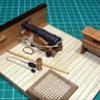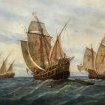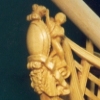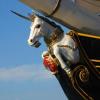Supplies of the Ship Modeler's Handbook are running out. Get your copy NOW before they are gone! Click on photo to order.
×
-
Posts
5,871 -
Joined
-
Last visited
Reputation Activity
-
 BANYAN got a reaction from Oliver24 in Coloring the mast
BANYAN got a reaction from Oliver24 in Coloring the mast
Hi Oliver, as Mark points out some masts were painted, others not. To establish what the masts in your ship/model were you need to research the ship and see if there is a common way of doing things for that era in the form of regulations, contract requirements, or for other ship contemporary for the period. Some ship's logs are great as there are often entries such as stripping and varnishing the lower masts etc.
If painted, again need to know the normal practice for that period in a war/merchant ship (they often differed) and in latter times mast colours were often governed by the owners/shipping line etc.
If you decide to paint, as Mark points out, you can either paint or leave bare, or use different wood types to 'paint by wood' as some modellers call it. A lot of ship masts were simply varnished and the normal weathering of varnish (on a model) may be sufficient for your needs. if painting, sometimes you need to 'tone down' the hue of the colour of the paint a bit for the model to keep the paint in perspective to the model.
Basically you need to research the ship type, era etc a bit first so that some of the more experienced here can then provide some better, more specific advice.
-
 BANYAN got a reaction from hexnut in HMCSS Victoria 1855 by BANYAN - 1:72
BANYAN got a reaction from hexnut in HMCSS Victoria 1855 by BANYAN - 1:72
Hi folks, another small update. Now that I have the PE in hand I can progress on a bit; still waiting for the 3D parts (capstan and revised funnel). I also had some laser parts cut for the engine room skylight as my attempts to make them kept breaking (stiles and rails) as the walls are only .6mm thick and the rails /stiles just .8mm. They have come up OK considering the size.
One of the reasons for lack of updates is that I had been busy drawing up all these part. The two sheets of PE are 0.4mm (larger sheet) and 0.2mm.
I am in the process of doing the glazing and have added the 'waffle' style ventilation louvres discussed earlier. The louvers were made from 0.2mm thick brass sheet and folded and soldered to get the effect seen in the photo earlier - they look OK I think? My biggest decision is whether to add another louvre in the front and after walls. I show a blank and a louvre version in the photos, but have an additional one of each.
My thoughts are to go for blank (no louvre) as I think there would have been adequate ventilation from the louvres and top pieces? The reasoning is that the after wall would most likely have been used to store the firehose racks, and supplementary 'L' shaped handle for the Downton pumps (only shipped as required.
I have started on the rod/bar grills for the top pieces with the parts shown before cleaning (one made, one unmade); the rods are only 0.6mm diameter. These have since been blackened but I forgot to take a photo. When the glazing in the top pieces have dried completely these will be glued over the windows / glazed parts.
I have also made the bases for the pumps, and manufactured one of the two suction plate assemblies required. The idea was that the connecting pipe(rounded/horseshoe shape) could be cross-connected to any one of three suction pipes (one to each major compartment/space). The top end of the pipe ran underdeck between the pipe and this plate assembly. I still have a 7" hose connection plate (single) to make which was the upper deck connection to the pump in the engine room (for firefighting) whereas the other two are for dewatering and transferring freshwater around the ship. The wood looks rough but I am zoomed right in and actually looks very smooth to the eye.
The 'pelorus' has also been completed. The 'hollow' look of the brass night cover for the compass is a trick of the light as I have painted that face silver to simulate the viewer.
These parts will be fitted once the engine room skylight has been fitted.
cheers
Pat
-
 BANYAN reacted to Louie da fly in Henry Grace a Dieu (Great Harry) by Louie da fly - FINISHED - Scale 1:200 - Repaired after over 50 yrs of neglect
BANYAN reacted to Louie da fly in Henry Grace a Dieu (Great Harry) by Louie da fly - FINISHED - Scale 1:200 - Repaired after over 50 yrs of neglect
Thanks, Druxey. Yes, it's 1:200. You can blame Bjorn Landstrom (sorry, can't add the correct accents to his name) - I directly copied it from the 1:200 reconstruction side view in his book The Ship. When I built it in 1970-odd, I carved three people out of bamboo to inhabit the ship. They were pretty tiny. Sadly, they got lost along the way along with many of the other nice detailed bits I made. Still, 1:200 pales into insignificance compared with the guys who routinely make ships at 1:350. I have no idea how they do it.
Patrick, you were right; the frame was out of line. I've fixed it and moved on somewhat, putting in cross-beams which will support the upper deck. This is all a bit rough and ready - I have yet to work out exactly the run of the deck - the black lines are where I think the deck will run - and of the hull below the water line. Which is part of the reason for using balsa - it's so easy to work and to "bodge" if it's bit out.
Still lots of work to be done, but slowly making progress.
Steven
-
 BANYAN reacted to RGL in SMS Seydlitz by Canute, Cog, Stein Gildberg & RGL - FINISHED - Hobbyboss - 1/350 - PLASTIC
BANYAN reacted to RGL in SMS Seydlitz by Canute, Cog, Stein Gildberg & RGL - FINISHED - Hobbyboss - 1/350 - PLASTIC
Stanchions in, a few hours now to rig
-
 BANYAN got a reaction from Obormotov in MONTAÑES by Amalio
BANYAN got a reaction from Obormotov in MONTAÑES by Amalio
Your joinery is an inspiration!
cheers
Pat
-
 BANYAN got a reaction from mtaylor in Great Republic 1853 by rwiederrich - FINISHED - four masted extreme clipper
BANYAN got a reaction from mtaylor in Great Republic 1853 by rwiederrich - FINISHED - four masted extreme clipper
You are motoring along Rob, very tidy!
cheers
Pat
-
 BANYAN got a reaction from paulsutcliffe in MONTAÑES by Amalio
BANYAN got a reaction from paulsutcliffe in MONTAÑES by Amalio
Your joinery is an inspiration!
cheers
Pat
-
 BANYAN got a reaction from mtaylor in Henry Grace a Dieu (Great Harry) by Louie da fly - FINISHED - Scale 1:200 - Repaired after over 50 yrs of neglect
BANYAN got a reaction from mtaylor in Henry Grace a Dieu (Great Harry) by Louie da fly - FINISHED - Scale 1:200 - Repaired after over 50 yrs of neglect
Missed the start of this one Steven, will be following with interest.
cheers
Pat
-
 BANYAN got a reaction from EdT in HMCSS Victoria 1855 by BANYAN - 1:72
BANYAN got a reaction from EdT in HMCSS Victoria 1855 by BANYAN - 1:72
Hi folks, another small update. Now that I have the PE in hand I can progress on a bit; still waiting for the 3D parts (capstan and revised funnel). I also had some laser parts cut for the engine room skylight as my attempts to make them kept breaking (stiles and rails) as the walls are only .6mm thick and the rails /stiles just .8mm. They have come up OK considering the size.
One of the reasons for lack of updates is that I had been busy drawing up all these part. The two sheets of PE are 0.4mm (larger sheet) and 0.2mm.
I am in the process of doing the glazing and have added the 'waffle' style ventilation louvres discussed earlier. The louvers were made from 0.2mm thick brass sheet and folded and soldered to get the effect seen in the photo earlier - they look OK I think? My biggest decision is whether to add another louvre in the front and after walls. I show a blank and a louvre version in the photos, but have an additional one of each.
My thoughts are to go for blank (no louvre) as I think there would have been adequate ventilation from the louvres and top pieces? The reasoning is that the after wall would most likely have been used to store the firehose racks, and supplementary 'L' shaped handle for the Downton pumps (only shipped as required.
I have started on the rod/bar grills for the top pieces with the parts shown before cleaning (one made, one unmade); the rods are only 0.6mm diameter. These have since been blackened but I forgot to take a photo. When the glazing in the top pieces have dried completely these will be glued over the windows / glazed parts.
I have also made the bases for the pumps, and manufactured one of the two suction plate assemblies required. The idea was that the connecting pipe(rounded/horseshoe shape) could be cross-connected to any one of three suction pipes (one to each major compartment/space). The top end of the pipe ran underdeck between the pipe and this plate assembly. I still have a 7" hose connection plate (single) to make which was the upper deck connection to the pump in the engine room (for firefighting) whereas the other two are for dewatering and transferring freshwater around the ship. The wood looks rough but I am zoomed right in and actually looks very smooth to the eye.
The 'pelorus' has also been completed. The 'hollow' look of the brass night cover for the compass is a trick of the light as I have painted that face silver to simulate the viewer.
These parts will be fitted once the engine room skylight has been fitted.
cheers
Pat
-
 BANYAN got a reaction from mtaylor in Fishing Smack c. 1920 by G.L. - FINISHED - Scale 1/20 - POF - cross-section
BANYAN got a reaction from mtaylor in Fishing Smack c. 1920 by G.L. - FINISHED - Scale 1/20 - POF - cross-section
That's very effective 'lagging' GL, and nice detail.
cheers
Pat
-
 BANYAN got a reaction from Landlubber Mike in Coloring the mast
BANYAN got a reaction from Landlubber Mike in Coloring the mast
Hi Oliver, as Mark points out some masts were painted, others not. To establish what the masts in your ship/model were you need to research the ship and see if there is a common way of doing things for that era in the form of regulations, contract requirements, or for other ship contemporary for the period. Some ship's logs are great as there are often entries such as stripping and varnishing the lower masts etc.
If painted, again need to know the normal practice for that period in a war/merchant ship (they often differed) and in latter times mast colours were often governed by the owners/shipping line etc.
If you decide to paint, as Mark points out, you can either paint or leave bare, or use different wood types to 'paint by wood' as some modellers call it. A lot of ship masts were simply varnished and the normal weathering of varnish (on a model) may be sufficient for your needs. if painting, sometimes you need to 'tone down' the hue of the colour of the paint a bit for the model to keep the paint in perspective to the model.
Basically you need to research the ship type, era etc a bit first so that some of the more experienced here can then provide some better, more specific advice.
-
 BANYAN got a reaction from Chuck Seiler in Deck gun cannons
BANYAN got a reaction from Chuck Seiler in Deck gun cannons
The cheapest way is to make them yourself if you have the time. These can be turned up on a lathe from brass, alluminium or wood rod (stock); or, buy/make one master and cast the remainder of them?
If you are willing to buy, have a look at ship model accessories at the many hobby shops/retailers and they stock additional/replacement parts from some of the bigger mass produced kits. You may find something that looks a bit like the guns you need close to scale made from britannia/white metal. Not as nice as brass turned barrels but a lot cheaper - but as the saying goes "you gets what yous pays" - Buying cheap will most often mean they will look 'cheap' on the model also unless you put a lot of additional work into them.
cheers
Pat
-
 BANYAN got a reaction from Obormotov in MONTAÑES by Amalio
BANYAN got a reaction from Obormotov in MONTAÑES by Amalio
I am always impressed with the quality of your work Amalio. The workmanship is simply stunning!
cheers
Pat
-
 BANYAN got a reaction from popeye the sailor in HMCSS Victoria 1855 by BANYAN - 1:72
BANYAN got a reaction from popeye the sailor in HMCSS Victoria 1855 by BANYAN - 1:72
Hi folks, another small update. Now that I have the PE in hand I can progress on a bit; still waiting for the 3D parts (capstan and revised funnel). I also had some laser parts cut for the engine room skylight as my attempts to make them kept breaking (stiles and rails) as the walls are only .6mm thick and the rails /stiles just .8mm. They have come up OK considering the size.
One of the reasons for lack of updates is that I had been busy drawing up all these part. The two sheets of PE are 0.4mm (larger sheet) and 0.2mm.
I am in the process of doing the glazing and have added the 'waffle' style ventilation louvres discussed earlier. The louvers were made from 0.2mm thick brass sheet and folded and soldered to get the effect seen in the photo earlier - they look OK I think? My biggest decision is whether to add another louvre in the front and after walls. I show a blank and a louvre version in the photos, but have an additional one of each.
My thoughts are to go for blank (no louvre) as I think there would have been adequate ventilation from the louvres and top pieces? The reasoning is that the after wall would most likely have been used to store the firehose racks, and supplementary 'L' shaped handle for the Downton pumps (only shipped as required.
I have started on the rod/bar grills for the top pieces with the parts shown before cleaning (one made, one unmade); the rods are only 0.6mm diameter. These have since been blackened but I forgot to take a photo. When the glazing in the top pieces have dried completely these will be glued over the windows / glazed parts.
I have also made the bases for the pumps, and manufactured one of the two suction plate assemblies required. The idea was that the connecting pipe(rounded/horseshoe shape) could be cross-connected to any one of three suction pipes (one to each major compartment/space). The top end of the pipe ran underdeck between the pipe and this plate assembly. I still have a 7" hose connection plate (single) to make which was the upper deck connection to the pump in the engine room (for firefighting) whereas the other two are for dewatering and transferring freshwater around the ship. The wood looks rough but I am zoomed right in and actually looks very smooth to the eye.
The 'pelorus' has also been completed. The 'hollow' look of the brass night cover for the compass is a trick of the light as I have painted that face silver to simulate the viewer.
These parts will be fitted once the engine room skylight has been fitted.
cheers
Pat
-
 BANYAN got a reaction from DORIS in HMCSS Victoria 1855 by BANYAN - 1:72
BANYAN got a reaction from DORIS in HMCSS Victoria 1855 by BANYAN - 1:72
Hi folks, another small update. Now that I have the PE in hand I can progress on a bit; still waiting for the 3D parts (capstan and revised funnel). I also had some laser parts cut for the engine room skylight as my attempts to make them kept breaking (stiles and rails) as the walls are only .6mm thick and the rails /stiles just .8mm. They have come up OK considering the size.
One of the reasons for lack of updates is that I had been busy drawing up all these part. The two sheets of PE are 0.4mm (larger sheet) and 0.2mm.
I am in the process of doing the glazing and have added the 'waffle' style ventilation louvres discussed earlier. The louvers were made from 0.2mm thick brass sheet and folded and soldered to get the effect seen in the photo earlier - they look OK I think? My biggest decision is whether to add another louvre in the front and after walls. I show a blank and a louvre version in the photos, but have an additional one of each.
My thoughts are to go for blank (no louvre) as I think there would have been adequate ventilation from the louvres and top pieces? The reasoning is that the after wall would most likely have been used to store the firehose racks, and supplementary 'L' shaped handle for the Downton pumps (only shipped as required.
I have started on the rod/bar grills for the top pieces with the parts shown before cleaning (one made, one unmade); the rods are only 0.6mm diameter. These have since been blackened but I forgot to take a photo. When the glazing in the top pieces have dried completely these will be glued over the windows / glazed parts.
I have also made the bases for the pumps, and manufactured one of the two suction plate assemblies required. The idea was that the connecting pipe(rounded/horseshoe shape) could be cross-connected to any one of three suction pipes (one to each major compartment/space). The top end of the pipe ran underdeck between the pipe and this plate assembly. I still have a 7" hose connection plate (single) to make which was the upper deck connection to the pump in the engine room (for firefighting) whereas the other two are for dewatering and transferring freshwater around the ship. The wood looks rough but I am zoomed right in and actually looks very smooth to the eye.
The 'pelorus' has also been completed. The 'hollow' look of the brass night cover for the compass is a trick of the light as I have painted that face silver to simulate the viewer.
These parts will be fitted once the engine room skylight has been fitted.
cheers
Pat
-
 BANYAN got a reaction from Beef Wellington in HMCSS Victoria 1855 by BANYAN - 1:72
BANYAN got a reaction from Beef Wellington in HMCSS Victoria 1855 by BANYAN - 1:72
Hi folks, another small update. Now that I have the PE in hand I can progress on a bit; still waiting for the 3D parts (capstan and revised funnel). I also had some laser parts cut for the engine room skylight as my attempts to make them kept breaking (stiles and rails) as the walls are only .6mm thick and the rails /stiles just .8mm. They have come up OK considering the size.
One of the reasons for lack of updates is that I had been busy drawing up all these part. The two sheets of PE are 0.4mm (larger sheet) and 0.2mm.
I am in the process of doing the glazing and have added the 'waffle' style ventilation louvres discussed earlier. The louvers were made from 0.2mm thick brass sheet and folded and soldered to get the effect seen in the photo earlier - they look OK I think? My biggest decision is whether to add another louvre in the front and after walls. I show a blank and a louvre version in the photos, but have an additional one of each.
My thoughts are to go for blank (no louvre) as I think there would have been adequate ventilation from the louvres and top pieces? The reasoning is that the after wall would most likely have been used to store the firehose racks, and supplementary 'L' shaped handle for the Downton pumps (only shipped as required.
I have started on the rod/bar grills for the top pieces with the parts shown before cleaning (one made, one unmade); the rods are only 0.6mm diameter. These have since been blackened but I forgot to take a photo. When the glazing in the top pieces have dried completely these will be glued over the windows / glazed parts.
I have also made the bases for the pumps, and manufactured one of the two suction plate assemblies required. The idea was that the connecting pipe(rounded/horseshoe shape) could be cross-connected to any one of three suction pipes (one to each major compartment/space). The top end of the pipe ran underdeck between the pipe and this plate assembly. I still have a 7" hose connection plate (single) to make which was the upper deck connection to the pump in the engine room (for firefighting) whereas the other two are for dewatering and transferring freshwater around the ship. The wood looks rough but I am zoomed right in and actually looks very smooth to the eye.
The 'pelorus' has also been completed. The 'hollow' look of the brass night cover for the compass is a trick of the light as I have painted that face silver to simulate the viewer.
These parts will be fitted once the engine room skylight has been fitted.
cheers
Pat
-
 BANYAN reacted to rwiederrich in Great Republic 1853 by rwiederrich - FINISHED - four masted extreme clipper
BANYAN reacted to rwiederrich in Great Republic 1853 by rwiederrich - FINISHED - four masted extreme clipper
Thank you very much.
I too, tend to pay close attention to details that may go unnoticed on other folks models. As you rightly pointed out..some, young in the hobby, make mistakes unbeknownst to themselves...and others, cleverly disguise or distract alterations/modifications for some unknown practical purpose. (Not forgetting the need at times for great artistic license due to lack of credible information). Both of these characterizations will cause the discrete educated observer to question. I appreciate your observation and most of all your desire to point out a blaring error that without proper explanation could leave a model and its builder with less than a reputable reputation.
I'm no expert....but I'm also no novice. More like a *Hack* then a purist.
Rob
-
 BANYAN reacted to G.L. in Fishing Smack c. 1920 by G.L. - FINISHED - Scale 1/20 - POF - cross-section
BANYAN reacted to G.L. in Fishing Smack c. 1920 by G.L. - FINISHED - Scale 1/20 - POF - cross-section
Smacks were often equipped with a steam capstan. In the 19th century the capstan was driven by a donkey steam engine which was connected to a gearbox below the capstan with a connecting rod. Later a more effective capstan was developed: the Elliott & Garrod's steam capstan. The steam under pressure could be led immediately from the steam pressure boiler to a gearbox on top of the capstan. This effected less loss of power than with connecting rods. The steam pressure boiler is situated outside the cross section, so I don't have to make it.
On the other hand, the capstan has to be made, but that is a job for later. On the picture a Elliot & Garrod's steam capstan of a later generation than that on my smack.
I start with lying the carlings on which will stand the capstan.
I drill a hole in the middle carling. Through that hole will lead the steam pipe to the capstan.
I curve a 4 mm brass tube which will lead from the upper deck to the lower deck.
Below the lower deck the steam pipe goes further horizontally to the engine room more aft. My steam pipe will be cut off at the edge of the cross section. I want to end the pipe with a flange.
Making the flange: drawing the outline on a piece of brass.
Making a hole in it
Making the boltholes
Sawing it out
Filing of the outline
Soldering the flange on the pipe.
Making a mounting bracket.
The steam pipe is leading along quite a long distance, including more than two meters through the ice cooled fish hold. I can imagine that there will be a significant loss of temperature of the steam. There is nothing told in the practicum about insulation of the steam pipe. During the twenties of last century the health risks of using asbestos were not yet known, so I suppose that the pipe was insulated with a layer of asbestos. I will do it as well on my model. I will of course not use real asbestos but I will try to make a look alike. To do so, I take a roll of gauze bandage.
I cut some narrow bars of it.
I wind them around the tube and moisten them with textile glue.
Then I paint them with white acrylic paint.
The pipes into their places. The pipe below deck still needs a support for a while until the glue is dry.
-
 BANYAN reacted to RGL in SMS Seydlitz by Canute, Cog, Stein Gildberg & RGL - FINISHED - Hobbyboss - 1/350 - PLASTIC
BANYAN reacted to RGL in SMS Seydlitz by Canute, Cog, Stein Gildberg & RGL - FINISHED - Hobbyboss - 1/350 - PLASTIC
The rear or main mast section
-
 BANYAN got a reaction from EJ_L in Royal Louis 1780 by Ulises Victoria - FINISHED - Mamoli - Scale 1/90 - French 126-gun ship
BANYAN got a reaction from EJ_L in Royal Louis 1780 by Ulises Victoria - FINISHED - Mamoli - Scale 1/90 - French 126-gun ship
Great progress UV and love the 'life's little adventures' along the way I cannot recount the number of time I went looking for things only to find them in the most obvious place
cheers
Pat
-
 BANYAN got a reaction from Ulises Victoria in Royal Louis 1780 by Ulises Victoria - FINISHED - Mamoli - Scale 1/90 - French 126-gun ship
BANYAN got a reaction from Ulises Victoria in Royal Louis 1780 by Ulises Victoria - FINISHED - Mamoli - Scale 1/90 - French 126-gun ship
Great progress UV and love the 'life's little adventures' along the way I cannot recount the number of time I went looking for things only to find them in the most obvious place
cheers
Pat
-
 BANYAN reacted to Dowmer in Great Republic 1853 by rwiederrich - FINISHED - four masted extreme clipper
BANYAN reacted to Dowmer in Great Republic 1853 by rwiederrich - FINISHED - four masted extreme clipper
😀 No worries Rob, I’m not really that anal. It’s just one of the things I look for since so many people get the orientation wrong (unknowingly). I understand, sometimes it is just practical at the scale you work. We all make sacrifices.
The ratlin’s look very uniform and tidy BTW. Nice job. 👍
-
 BANYAN reacted to rwiederrich in Great Republic 1853 by rwiederrich - FINISHED - four masted extreme clipper
BANYAN reacted to rwiederrich in Great Republic 1853 by rwiederrich - FINISHED - four masted extreme clipper
Good catch.....I intentionally placed the channel deadeyes upside down to facilitate the means by which I attached the deadeyes to the channels.
Holes were drilled up and into the deadeyes so a wire could *bolt*(In my case glue) the deadeye in place.
if the scale of the model had been larger then 1/128...say 1/96 or 1/72...I would have stropped the eyes with banding as would have been typical. I chose the more expedient compromise.
Like I've said before...I'm not a purist...but I sure know the difference. Nearly 48 years of passionate study of the subject allows me the license to alter minor details to satisfy the need to actually have a completion date for this model......
In my case the modification nearly goes unnoticed....unless close-up pics are provided to give away the modification.
I've been found out.
Here are some finished foot ropes...that are NOT typically fixed with clove hitches.
-
 BANYAN reacted to Louie da fly in Henry Grace a Dieu (Great Harry) by Louie da fly - FINISHED - Scale 1:200 - Repaired after over 50 yrs of neglect
BANYAN reacted to Louie da fly in Henry Grace a Dieu (Great Harry) by Louie da fly - FINISHED - Scale 1:200 - Repaired after over 50 yrs of neglect
I agree, Dick. However, it will be a while before I'm confronted by this problem and I've decided not to worry too much about it till then (the problems I have to resolve at the moment are quite enough for the time being). I'll be re-using as much of the original upper-work planking as I can, but there'll be a certain amount of new stuff I'll have to add, and the whole of the hull below the water line needs new planking.
What I have now is walnut, rather than the "Queensland walnut" I used when I first built her. I think I'll be trying to match the timbers as closely as possible; the overall goal is to repair her to be as she would have been at the time, rather than to show up the repairs. The main deck is bamboo, made from old blinds. I may be able to get something similar. If not, I have a piece of bamboo I'll probably cut into planks for the upper deck.
I've added the extra frames I needed. I had to reverse engineer frames, to be the right size to fit inside the existing planking (instead of making the frames first and then putting the planking on afterwards). The second-last frame is a bit skewiff so I'll have to undo and re-glue it, properly square.
I've marked where the tops of the upper deck-beams will be on each of the new frames, and now I have to decide exactly what to do next. I'll be putting beams in, of course, but I may cut the frames off above the beams and add false frames where they're visible, in some wood more appropriate than balsa.
Steven
-
 BANYAN got a reaction from pontiachedmark in Deck gun cannons
BANYAN got a reaction from pontiachedmark in Deck gun cannons
The cheapest way is to make them yourself if you have the time. These can be turned up on a lathe from brass, alluminium or wood rod (stock); or, buy/make one master and cast the remainder of them?
If you are willing to buy, have a look at ship model accessories at the many hobby shops/retailers and they stock additional/replacement parts from some of the bigger mass produced kits. You may find something that looks a bit like the guns you need close to scale made from britannia/white metal. Not as nice as brass turned barrels but a lot cheaper - but as the saying goes "you gets what yous pays" - Buying cheap will most often mean they will look 'cheap' on the model also unless you put a lot of additional work into them.
cheers
Pat














